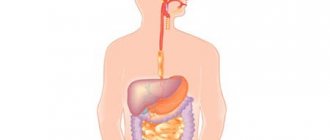Article prepared by:
Vasily Babkinsky
Doctor of the highest category
Paraproctitis in children can occur in acute or chronic form. Typically, the pathology manifests itself in newborns up to 12 months. The deviation is characterized by an inflammatory process in the area that surrounds the lower rectum. Treatment of the disease is mandatory and necessary to prevent the development of complications and transition to a protracted form. The disease is most often present in boys. The primary cause of infection is pathogenic microorganisms.
Paraproctitis is a disease of the colon
Root causes contributing to the formation of deviations
The causes of paraproctitis in infants are similar to the etiology of the disease in adults. Infection occurs when pathogenic microorganisms enter the intestinal tract. The development of pathology is possible with a decrease in the protective functions of the body.
The main provoking factors of pathology include:
- failure to comply with personal hygiene rules;
- injury in the anal area;
- diseases of the anus.
The risk of developing pathology increases significantly with regular stool disorders. This is possible with prolonged diarrhea or constipation. Often the disease is a consequence of existing proctological abnormalities.
The causes of paraproctitis in infants contribute to the entry of staphylococcus into the body. It is because of this microorganism that the deviation develops. Children are more susceptible to developing disorders due to weak protective functions.
We have selected useful articles on the topic
Description of Citrobacter and the danger of bacteria to human health
01.05.2019
Rectum: how and why cancer forms
19.06.2019
Initial signs of sigmoid colon cancer
02.05.2019
The cause of the development of the disease is often the entry of pathogenic microorganisms into the human intestines.
Another reason for the formation of a deviation is blockage of the anal gland passage. The infection begins to actively move, first to the deeper surfaces of the intestine, and then to the perirectal tissue.
Any prolonged infection can cause a deviation. These include caries, tonsillitis and sinusitis. Pathology can also be a consequence of domestic or surgical injuries.
Types of disease
The pathology is divided into two types, each of which is described in the table.
| Form of the disease | Description |
| Protracted | Chronic purulent paraproctitis in infants is often the result of improper treatment. The baby may develop a fistula. After self-therapy, a scar remains in the area of the anal sphincter, which becomes inflamed again at the slightest weakening of the body. Even the most common constipation can cause the condition to worsen. If there is a fistula in the anal area, the child secretes pus or ichor. For this reason, the skin is very irritated. The baby is bothered by severe itching. Symptoms are periodic and often occur after defecation. There is a high risk of the formation of malignant neoplasms. A rectal fistula in a child, which is present in a protracted form, is small in size. Usually the diameter of the neoplasm does not exceed several centimeters. Symptoms of deviation are most pronounced at the time of exacerbation. Over time, the fistula can become clogged with dead tissue, ichor, etc. This slows down the outflow from the perirectal tissue, and the inflammatory process develops again. The period of remission occurs when the abscess bursts. |
| Acute | Acute paraproctitis in children is characterized by the severity of symptoms. It is divided into several types depending on the location and prevalence of the flow. The disease happens:
Subcutaneous acute paraproctitis in infants is explained by the destruction of subcutaneous tissue in the perianal area. Easiest to treat. The symptoms of the acute form of the pathology cause severe discomfort. The baby may cry during bowel movements. If there is a deviation, the body temperature increases. |
It is important to prevent the disease from becoming protracted. In another situation, the symptoms will be constantly present and periodically intensify.
Additional symptoms may appear. Depending on the presence of complications, the disease can be:
- complicated;
- uncomplicated.
Paraproctitis is diagnosed more often in boys than in girls
Features of paraproctitis
Paraproctitis is a disease that affects the fatty tissue of the lower rectum (sphincter area). In newborns and infants, the disease most often occurs in two forms:
In addition, in the case of abscess formation, paraproctitis is determined by its location:
- Subcutaneous.
- Ischiorectal.
- Submucosal.
- Retrorectal.
- Pelvic-rectal.
As medical practice shows, the most common form of the disease in children is the acute subcutaneous form. The remaining varieties are observed very rarely.
According to medical statistics:
- 66.6% of children from birth to 14 years old suffered from an acute form.
- 33.3% – chronic.
At the same time, children under 6 months make up about 60% of the total number of those who have recovered from the disease.
For purulent paraproctitis:
- 62% – from 0 to 6 months.
- 20% – from 6 to 12 months.
Of the total number of patients, 95% are boys. This is due to the fact that in girls the pressure in the rectum is lower, so the risk of infection is negligible.
As you can see, after the first year of life, the likelihood of contracting this disease decreases significantly.
Symptoms of deviation
The main signs of paraproctitis in a child are constipation or, conversely, loose stools. In addition, it is possible to have:
- pain during bowel movements;
- decreased appetite;
- increased body temperature;
- tearfulness;
- child's worries.
There is severe swelling in the anal area. Most often, children have an acute form of pathology. In the presence of this type of deviation, the child cries during bowel movements due to unbearable pain.
Acute childhood paraproctitis is accompanied by constant pain in the anal sphincter area. There are bumps and redness near the anus. All new growths are warm to the touch. The skin of the buttocks changes color.
One of the signs of the disease is poor appetite
The folds of the mucous membrane become smooth. In the presence of an acute form, purulent discharge is possible. Necrotic tissue destruction is present. In the presence of an acute form of pathology, body temperature increases. The condition is rapidly deteriorating. Irritability appears and performance decreases. The patient feels discomfort when urinating. There is a fever.
The child may have a false urge to defecate. There is weakness and apathy. The baby complains of a painful sensation in the abdomen. On palpation the symptom intensifies significantly. Purulent and bloody discharge is possible.
Chronic paraproctitis in newborns is manifested by the presence of a fistula.
There is an external and internal through defect. Depending on its location, neoplasms are:
- full;
- incompletely open;
- incompletely closed.
With an exacerbation of the chronic form, the symptoms are similar to the acute type of the disease. The condition worsens quite often. Deviation cannot disappear on its own. The child must be taken to a medical facility for diagnosis and selection of therapy.
Types and classification
Depending on the course of the disease, it can be acute or chronic. The second form makes itself felt if the acute form is not treated for a long time. The formation begins with a fistulous tract.
He can be:
- Full. In this case, the fistula has an outlet into the intestine and into the skin area of the anus.
- Incomplete with closed exit. In this case, only one exit to the intestine is open.
- Partial with open exit. In this case, the hole is only in the skin and the process does not affect the anus.
The chronic form is periodically aggravated by an acute course when infected.
Sometimes children already have a fistulous tract at birth, but it is not filled with pus. In this case we are talking about congenital pathology. Over time and when infection occurs, the cavity fills with pus. If exudate accumulates, purulent paraproctitis begins.
According to the location of the abscess, they are distinguished:
- submucosal appearance;
- retrorectal;
- subcutaneous;
- pelvic-rectal;
- ischiorectal.
The subcutaneous acute type is more common.
Diagnostic methods
Paraproctitis in an infant can be suspected during the initial examination. There is swelling and redness in the anal area. The shape of the anus is deformed.
The affected area must be palpated. When palpated, the child experiences severe pain. The neoplasm is dense and hot. The doctor clarifies the unpleasant signs the baby has. Typical clinical symptoms include:
- chills;
- discomfort when palpating;
- signs of purulent inflammation.
If there is paraproctitis in children under one year of age, treatment is selected only after a final diagnosis has been established. A small patient needs differential diagnosis. It is necessary to exclude similar pathologies. The main instrumental method is anoscopy. Directions are also given to:
- radiography;
- sigmoidoscopy;
- fistulography.
The video shows a description of paraproctitis and treatment:
Diagnostics
It is enough for a proctologist to conduct a survey of the patient and a palpation examination to accurately make a diagnosis. The presence of the disease is indicated by an inflammatory process, pain, and swelling.
Before prescribing treatment, it is mandatory to undergo tests and examinations:
- general and biochemical blood test;
- urine;
- Ultrasound;
- radiographs;
- assessing the condition of the intestine using a probe, but this manipulation is rarely prescribed.
The presence of a bacterial environment can be seen by the number of leukocytes and ESR. Sometimes consultation with a pediatrician and surgeon is necessary.
Possible complications
Paraproctitis in infants can cause a purulent process to enter the pelvic space. The entire intestinal wall melts. The output of fecal matter is disrupted. All nearby internal organs are affected and sepsis is formed.
Paraproctitis can lead to the development of peritonitis. Pus enters the retroperitoneal space. This complication is possible if you do not consult a doctor in a timely manner.
The pathology can be complicated by an abscess breaking into the genitals. When the abscess opens independently, a fistula tract develops. The condition is gradually worsening.
Untimely treatment can lead to the development of peritonitis
Treatment measures
Treatment of paraproctitis in infants is carried out under the careful supervision of a doctor. The only method of getting rid of the deviation is surgery. It is carried out in both acute and protracted forms.
Operation for paraproctitis consists of:
- opening of a purulent neoplasm;
- cavity drainage;
- eliminating the inflamed crypt and blocking the passage.
Read also: methods of treating paraproctitis without surgery.
After surgery, the patient must take antibacterial drugs and medications to restore the body's protective functions. The deviation may reoccur. In the absence of timely treatment, complications develop. You need to see a doctor as soon as possible.
Treatment of paraproctitis in infants without surgery is impossible. With the help of various medications it is possible to improve the condition, but not eliminate the deviation completely.
Surgery is the only method of treating pathology










